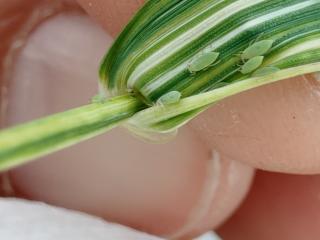Western Australia
September 7, 2020

A wealth of information about Russian wheat aphid, including what to look for and treatment options is available on the Department of Primary Industries and Regional Development’s website.
A wealth of information to assist Western Australian grain growers help slow the spread of Russian wheat aphid is available on the Department of Primary Industries and Regional Development’s website.
The exotic pest has now been confirmed in more than a dozen locations in the Esperance region, as the department continues to receive surveillance reports from local growers, consultants and its staff.
Russian wheat aphid is a pest of wheat, barley and to a lesser extent oat crops and can be found in grass weeds, like brome and barley grass.
The department’s ‘Russian wheat aphid: production pest’ webpage provides a one-stop-shop for information and data, available via a link on its homepage.
The pages include details on symptoms and what to look for, chemical control options, permits and seed treatments, reporting methods and on-farm biosecurity protocols.
The PestFax Map is being updated to illustrate confirmed detections of Russian wheat aphid to provide up to date information on the pest’s movement and will be included in the PestFax newsletter and available online.
Chief Plant Biosecurity Officer Sonya Broughton encouraged continued reporting of both the presence and absence of aphids and associated damage via the department’s reporting apps and its Pest and Disease Information Service to help map the pest’s spread.
Dr Broughton suggested the use of a hand lens or smartphone macro lens, as aphids were small and difficult to detect.
“Aphids colonise the edges of crops first so it is best to monitor the 20 metre edge of paddocks for signs of aphids or crop damage,” she said.
“When inspecting crops it is useful to get down on your hands and knees to inspect the leaves and the crown of the plant where aphids may hide.
“Look for white, yellow, purple or red streaking, leaf curling, stunted plant growth and loss of vigour. A noticeable loss of green colouration across the crop may indicate aphid damage.”
While Russian wheat aphid was confirmed for the first time in WA last month, the pest was first discovered in South Australia in 2016 and has since been found in Victoria, parts of New South Wales and Tasmania.
It was determined in 2016 that it was not feasible or cost beneficial to eradicate the pest from Australia, due to its biology and ability to spread on the wind.
Dr Broughton said a range of chemical control options were available to growers, which had proven to be effective in the eastern States.
“WA grain growers are adept at managing crop pests and Russian wheat aphid is another insect that can be managed by their crop protection program,” Dr Broughton said.
“Much has been learnt over the past four years from the research and experiences of growers across the Nullarbor about what action to take to minimise the impact of this pest on crop production and profitability.”
For more information on control options visit agric.wa.gov.au/russianwheataphid
Download the department’s MyPestGuide Reporter or PestFax Reporter apps to report the presence and absence of aphids or call the Pest and Information Disease Service on 9368 3080 or send a photo to padis@dpird.wa.gov.au. Samples should only be sent if requested to do so.